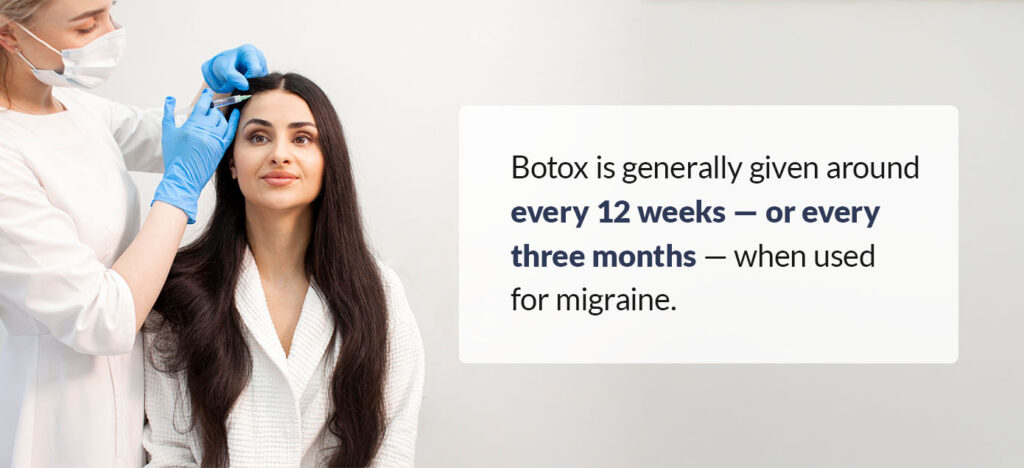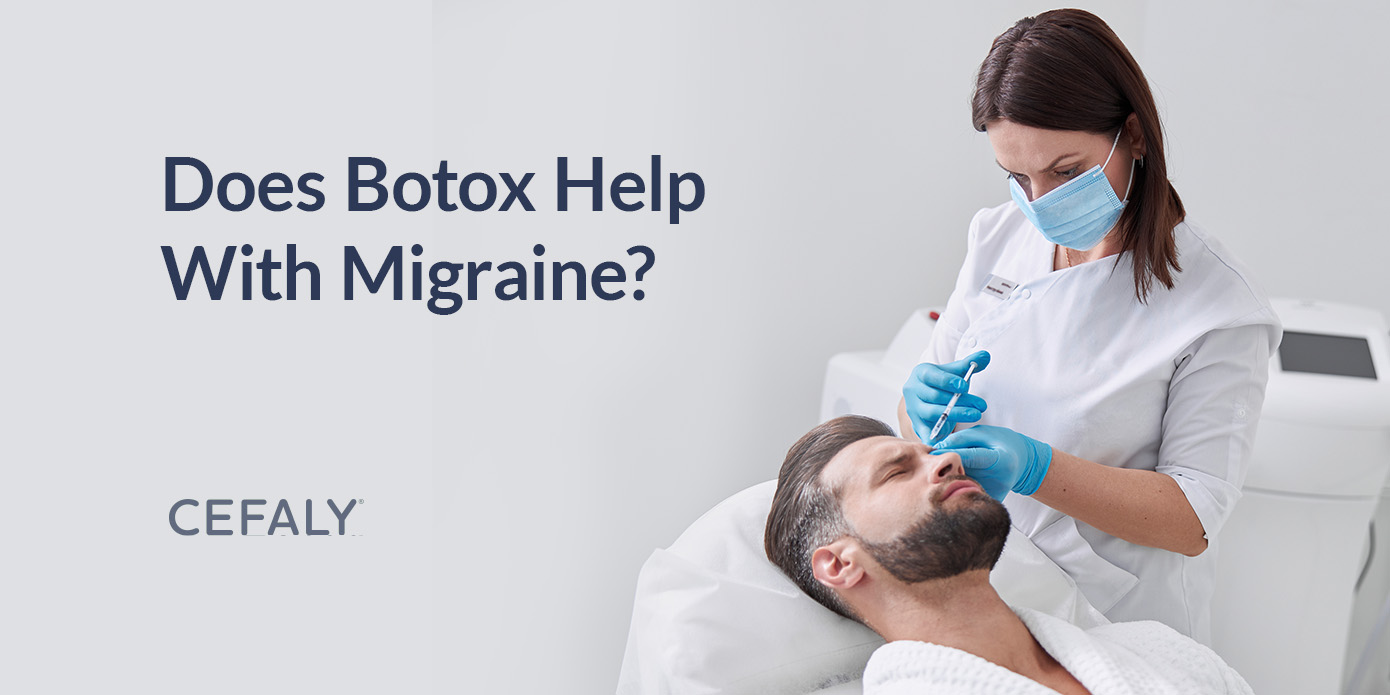You may know Botox as a cosmetic injection that helps smooth wrinkles and give people a younger look. Botox can also be used to treat certain medical conditions, like migraine.
The United States Food and Drug Administration (FDA) approved Botox for chronic migraine in 2010. Since then, Botox has become the No. 1 prescribed branded injectable for chronic migraine prevention based on data gathered between 2018 and 2024.
We’ll answer all your questions regarding Botox for migraine in this blog.
- How does Botox help with migraine?
- What should you expect while getting Botox for migraine?
- Where do they inject Botox for migraine?
- Does Botox for migraine change your face?
- How often should you get Botox for migraine?
- What should you not do after getting Botox for migraine?
- How much does Botox for migraine typically cost?
- Does insurance cover Botox for migraine?
How does Botox help with migraine?
Botox is a popular brand name for the type A form of botulinum toxin (onabotulinumtoxinA). Botulinum is a neurotoxin made by the Clostridium botulinum bacteria, which causes a type of food poisoning known as botulism. Injecting tiny, purified doses of this toxin into the nerves of specific areas, typically the forehead, temporarily paralyzes the muscles in these areas for a few months.
Although the injection has its cosmetic purposes, Botox can also help manage chronic migraine. Botox blocks the release of acetylcholine — a neurotransmitter that activates the trigeminal nerve. The trigeminal nerve is the primary pathway for migraine pain. By blocking its release, Botox can be an effective migraine treatment.
A 2022 study found that using onabotulinumtoxinA in people with chronic migraine decreased their attack frequency per month. They also found that it reduced their pain intensity, medication use, and migraine-related disabilities.
Note that Botox is recommended for people with chronic migraine. This includes people who have 15 or more headache days per month, eight of which involve migraine symptoms. Botox is also only recommended for people 18 years and older. The effects also last about three to four months, so you’ll need regular treatment.
Get Drug-Free Migraine Relief With CEFALY
Shop Now
90-day money back guarantee
FDA-cleared
financing available
Botox and migraine FAQ
If you’re curious about using Botox for migraine, you likely have a few questions.
What should you expect while getting Botox for migraine?
A Botox procedure for migraine is quick and done in a medical setting. In around 20 minutes, a healthcare professional will use a small needle to inject Botox into specific areas around your face, neck, and shoulders. Each injection will take a few seconds. As with any procedure using needles, you may feel mild discomfort from the tiny pinches, but most people find it tolerable.
After the session, the injected areas may feel tight or tender, but these feelings typically go away within a day or two. There’s no downtime after the procedure, so you can immediately return to your normal activities. That said, results aren’t instant. It may take a few weeks to notice a difference, with the treatment’s full effects appearing after multiple sessions. Some people may experience temporary side effects like mild bruising or neck pain afterward.
Know that Botox does not cure migraine — it merely helps reduce the frequency and intensity of attacks.
Where do they inject Botox for migraine?
Botox injections are placed in specific trigger point areas when used for migraine. Injection sites could include the following:
- Forehead
- Temples
- Back of the head
- Upper neck
- Shoulders
Doctors carefully select these spots because they’re linked to migraine pain pathways. Botox blocks pain signals and helps relax muscles in these areas. You may feel tiny pinpricks and experience minimal discomfort. Some areas, like the forehead, can be more sensitive than others. That said, the pain is usually brief.
Does Botox for migraine change your face?
Not necessarily. When used to treat migraine, Botox is injected into areas that affect headache pain — it is not used for cosmetic reasons. However, depending on the injection location, some people may notice subtle changes. For example, if Botox is injected in or near the forehead muscles, it may soften the lines or slightly lift the eyebrows.
Cosmetic changes are not the goal of the treatment, and when done correctly, Botox for migraine shouldn’t dramatically alter your appearance. If you’re concerned, however, talk to your healthcare professional before the session.
How often should you get Botox for migraine?
Botox is generally given around every 12 weeks — or every three months — when used for migraine. Sticking to this schedule may help prevent migraine from returning too frequently.
It also takes time for Botox to work, so there may not be immediate relief after the first treatment. For some people, it may take several weeks before they notice any difference from the Botox injection for migraine.

What should you not do after getting Botox for migraine?
Aftercare is just as important as getting the injection itself. Here’s what not to do after the procedure:
- Lie down: Staying upright after a treatment prevents Botox from potentially moving to other unintended areas. You may need to stay upright for at least a few hours.
- Rub injection sites: Leave the injected areas as-is. This means no rubbing, massaging, scratching or touching these areas. Doing so may irritate them and lengthen your healing time.
- Do exhausting activities: Avoid strenuous exercise and dramatic facial expressions for at least 24 hours. Exhaustive activities may prevent your Botox injection from properly settling into its intended areas.
- Get too hot: Excessive heat or sunlight on exposed Botox injection sites may cause them to become inflamed. This could result in prolonged swelling and redness. Practice good sun care and protection for at least 24 hours after the treatment.
- Wash your face: Try not to apply skincare products with harsh ingredients, such as retinoids, after getting your Botox injection.
- Consume alcohol: Wait for about 24-48 hours after getting your injection before drinking. Alcohol is a blood thinner and could increase bruising at injection sites.
- Take blood thinners: Similar to the above, taking blood thinners like aspirin can increase the likelihood of bleeding and bruising. Avoid them for at least 24 hours after your Botox injection.
Remember to stay hydrated and practice proper Botox aftercare to help boost your healing time — patience is key!
How much does Botox for migraine typically cost?
The list price for Botox is typically around $1,200 per 200-unit vial. That said, this amount may not be the price individuals pay for a session. The American Society of Plastic Surgeons states that the average Botox session costs $435. The Botox Savings Program could help reduce the cost of a session.
Does insurance cover Botox for migraine?
Yes, Botox is FDA-approved for chronic migraine management, which means most commercial insurance plans cover its costs. Medicaid and Medicare also cover this treatment. However, you’ll need approval from your insurance company to use this treatment. To get approved, you’ll need to have tried two other treatments without improvement. If you want to use Botox for other types of headaches, it’ll be considered “off-label,” and your insurance company may not cover the costs.
The amount covered by an insurance company may vary depending on your plan, so it’s important to do thorough research if you’re considering Botox for migraine.
Try CEFALY to prevent and relieve migraine
Migraine is a complex neurological condition that requires a comprehensive management approach. If you’re considering Botox for migraine, you can supplement this treatment with noninvasive, prescription-free options like CEFALY.
CEFALY is an FDA-cleared and clinically proven medical device that uses external trigeminal nerve stimulation (eTNS) to alleviate acute migraine attacks and prevent future episodes. And yes, you can use CEFALY with Botox! Simply wait 48 to 72 hours after your Botox injection before using the CEFALY device.
Try CEFALY’s products today to experience the relief for yourself!















